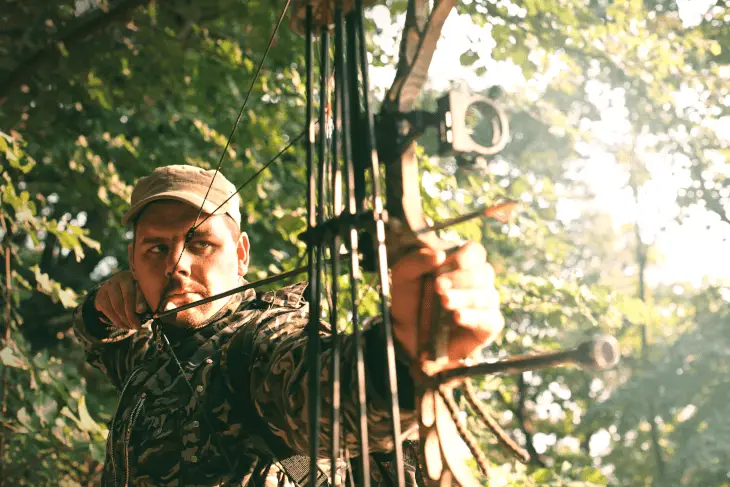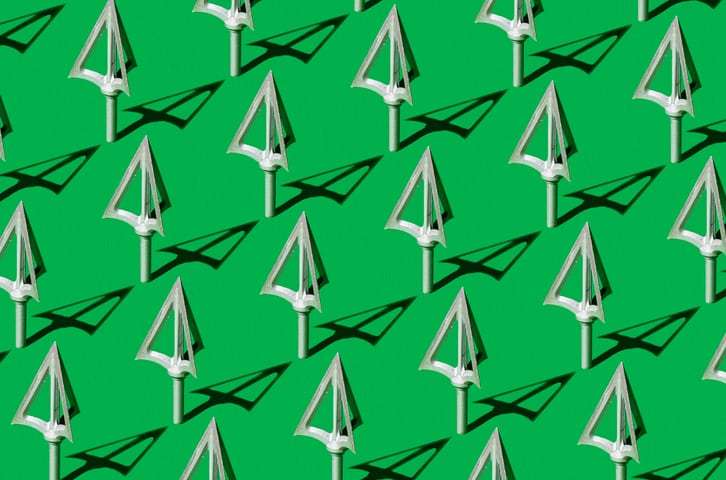Note: Our site links to archery and bowhunting products sold by outside vendors, and we may earn a small commission if you purchase an item after clicking one of these links. Learn more about our affiliate program.
In this post, we’ll discuss a piece of equipment that many bow hunters find essential: broadheads. When shot accurately from a powerful bow, broadheads can be incredibly effective hunting tools, and they can deliver the lethal force necessary to turn an unsuccessful hunt into one that puts dinner on your table.
If you’re a veteran bow hunter, our reviews below will describe the strength of each model, and how each model is unique; if you’re a new bow hunter, our discussion will help you find the best broadheads for your hunt, but we’ve also included an in-depth guide to broadheads after the reviews, where we offer a full description of broadheads, including the different types available, their features, and how to choose the right broadhead for you.
Let’s jump right in.
Fixed Blade Broadheads: Top Picks
Fixed blade broadheads are known for their simplicity, their sturdiness, and their reliability. They’re not as fancy as mechanical broadheads, but when they’re properly tuned, they can literally put down an animal of any size, from turkeys and deer to bison and bear.
There are five models we like, and we’ve broken them down into the best two-blade, three-blade, four-blade, chisel-tip, and best replaceable blade options.
First up:
Carbon Express Nativ Broadhead
Our pick for the best two-blade broadhead; excellent for penetration and a good choice for new bowhunters / traditional bow hunters shooting lower-poundage bows
- Solid 2-blade style
- Versatile - use with low to high poundage bows
- Aircraft-grade aluminum ferrule for superior lightweight strength
Pros:
- Good for a wide range of draw weights;
- Less likely to be influenced by wind;
- Fly like field tips
Cons:
- Flat broadheads require a bit of precision in order to hit a vital organ
Double-bladed broadheads like the Carbon Express XT are designed for easy penetration, and that makes them a great fit for bow hunters using lighter-poundage bows, newer bow hunters, and traditional archers, who aren’t shooting with all the power of a compound. Because they have less surface area than larger broadheads, they tend to fly a little more like field tips, and that can translate into a little more confidence in your shot placement.
These are the “OG” of fixed blade broadheads: they feature as simple a design as you’ll find—it’s basically the same design as bow hunters used many millennia ago—but instead of stone, the ferrule is made from aluminum-grade, and the cutting points are literally razor blades. Simple, old-school, but effective. If you’re looking for tried-and-true and reliable, it doesn’t get simpler than this.
G5 Outdoors Montec Broadheads
Our pick for the top three-blade / single piece broadhead; very powerful and capable of crunching through bone—a good option if you’re not certain you’re capable of making a “vitals only” shot
- PINNACLE OF BROADHEADS - The Montec Broadheads have a tough all-steel construction, ensuring unmatched durability; The one-piece MIM (Metal Injection Molding) construction eliminates any weak points
- SPIN-TESTED PERFECTION - Each Montec Broadhead is 100% spin-tested to guarantee perfect balance and accuracy and ensure every broadhead flies true, enhancing your shot precision
- GRAIN OPTIONS - The Montec Broadheads are available in three different grain options: 85, 100, and 125 grains; This variety allows hunters to choose the perfect weight
Pros:
- No moving parts to replace or maintain;
- Can last a long time with proper care;
- As sharp as you can make them
Cons:
- Need to re-sharpen blades individually after use
Single-piece broadheads like the G5 Outdoors Montec are similar to two-blade arrowheads, because they’re sturdy, sharp, and reliable. That single design enhancement—their third blade—creates a third cutting path inside the animal, and that can mean more internal damage.
The real benefit, though, is their ability to pass through game. When shot from a strong bow and an appropriately stiff arrow, single-piece broadheads have been known to cut not only through muscle and tissue, but through bone. That can be an advantage from any angle—if you’re on the ground, taking broadside shots or quarter shots that are slightly imperfect, or if you’re shooting from a tree stand, and need to penetrate from above through a shoulder bone.
Muzzy Bowhunting Phantoms with Bleeder Blade
Our choice for the most capable four-blade broadhead; the fixed blade broadhead capable of creating the big exit wounds and thick blood trails, so that you can find your game after you shoot it
No products found.
Pros:
- Extensive cutting surface;
- Great choice for small to large game;
- Feature as many blades as you can fit on a fixed blade broadhead!
Cons:
- Extra blade surface makes them susceptible to strong wind
The best broadheads will have an extensive cutting surface, and that’s one of the strengths of the Muzzy Bowhunting Phantoms: the number of blades you have on your broadhead is directly related to the size and visibility of the blood trail your game will leave, and that makes sense—with four blades slicing through muscle fibers, your game is more likely to bleed and keep bleeding. The main blades on the Phanton are 1.125 inches thick (a very respectable width), and two bleeder blades are nicely sized and can assist in creating a blood trail.
Four blades are about as much as a fixed blade can give you, and because they’ve got so much “slicing surface” combined with the durability of a fixed blade, they’re a good option for game of all sizes, from turkey to elk.
The Muzzy Bowhunting Trocar Tip Broadhead
A great chisel-tip option; with its punch-through power, three blades, and blood trail potential, it gets our pick for best fixed blade option overall—very powerful
- BONE CRUSHING PENETRATION – Hardened steel Trocar tip provides maximum penetration and enhanced flight stability
- 100 GRAIN BROADHEADS - 3 Blade broadhead for use in standard inserts - 6 Pack - Also available in 75 and 125 grain
- CUTTING DIAMETER - .020 inch blades with 1-3/16" cutting diameter. Anodized aluminum ferrule
Pros:
- Sturdy Trocar chisel tip punches through hide;
- Blades have excellent penetration power;
- Blades can be replaced after a hunt
Cons:
- Practice broadhead in package is so-so
If you look closely at tip on the Muzzy Bowhunting Trocar Tip Broadhead, you’ll see that it’s chiseled down like an old pencil tip. The word “trocar” means “three edges,” and that chiseled design can be very helpful, because it enables the broadhead to punch through hide of the animal and lodge the arrow inside of the animal before the trajectory of the arrow can be altered.
It’s a huge bummer when you take a clean, accurate shot, only to have your arrow enter the angle at a weird angle and be ineffective, and the trocar tip lodges in the animal before it can ping off in a weird direction. That trocar tip is strong, too—because that trocar tip is a solid piece, it’s sturdy, and known to cut through bone.
Combine the punching power of the trocar tip with three aggressive cutting blades that can be replaced after every hunt with brand-new razors, and this gets our vote for the most effective fixed blade broadhead.
QAD Exodus Non-Barb Broadheads
A durable replaceable-blade option if you don’t have the time or patience to hand-sharpen one-piece broadheads
- Super short fixed blade broadhead;Steep cutting angle and SST tip;1 1/4" cutting diameter;.040" blade thickness
Pros:
- Replaceable blades;
- Steep cutting angle;
- Very thick cutting blades
Cons:
- Only manufactured in 100 grains
The obvious benefit of the QAD Exodus Non-Barb Broadheads is that they’ve got replaceable blades: after a hunt, you just remove the blades, and drop in new ones. Easy peasy, no fuss no muss, good to go. Sharpening blades can be a drag (and sometimes dangerous), and if you don’t have all the time in the world—maybe you’re a dad/mom who works a lot, or you simply have a lot to do—the option of quickly getting your broadheads in shooting shape is pretty fantastic.
That said, the QAD Exodus broadheads have a lot else going for them, too: the blades themselves are very thick, and they feature a very steep cutting angle. If you look at most fixed heads, the blades slope backwards, but on the Exodus, it looks like they’re at a 45-degree angle. That’s very aggressive, and that can translate to a lot of cutting power inside the animal.
(Note: these are the “non-barb” option, and we’ve chosen them for that reason—some states don’t allow barbed broadheads.)
Mechanical Broadheads: Top Picks
Mechanicals don’t always have the ruggedness that fixed blades feature, but they’re known for flying a lot more accurately, and creating very large exit wounds and bright, vibrant blood trails—features any bow hunter loves to see.
Below, we’ll go over our favorite models, and discuss what makes each of them unique.
The Rage Hypodermic Broadhead
A rear-deploying broadhead designed for easy penetration; one of the best mechanical options for novice to intermediate bow hunters
- PRECISION - Rage broadheads are known for their accuracy and their wound channels are legendary
- PENETRATION - the swept back blade design reduces friction with increases penetration. Ideal for larger game animals or for lower poundage bow setups needing maximum penetration
- AERODYNAMIC FERRULE - One-piece aerodynamic stainless steel ferrule and exclusive Hybrid Tip have Razor sharp .035" stainless steel blades and 1.5" Cutting diameter
Pros:
- Designed to fly like a field point;
- Very sharp cut-on-contact point;
- 1.5-inch cutting diameter creates medium-sized wound channel
Cons:
- Chisel tip could be a little bit sharper
The Rage Hypodermic Broadhead is a great example of a rear-deploying mechanical broadhead: as the broadhead flies through the air, its blades are swept snugly inwards, so it experiences less friction as it travels—designed to result in less drag and little more accuracy. The Rage is designed to fly like a field point, and if you’re a new bow hunter, that’s a great place to start—you may have fewer surprises when it comes to putting your arrows where you want them.
The cutter diameter on the Rage is 1.5 inches, which makes this a good option for medium draw-weight bows. It’s thick enough to create a wide entry wound and a wide exit wound, but because it’s on the thinner side, it will experience a little less friction, and may be less likely to get stuck inside the animal. The chisel tip, too, is a nice option—it could be a little bit sharper, but it’s very thin, designed for quick penetration of the animal.
The Ramcat Hydroshock Pivoting Broadhead
A very unique broadhead, made in the spirit of a fixed blade—sturdy, and can do sizeable internal damage to drop your game near the spot you shot it
- PIVOTING BROADHEADS: Pivots as needed to keep arrow driving on impact, even when coming in contact with bone
- AIRFOIL AERODYNAMICS: Deep lobes on tip creates an airfoil that eliminates wind planning for field-point accuracy and better flight
- BACK CUT TECHNOLOGY: 0.032-inch, rear-sharpened, stainless steel blades are silent in flight and in the event of no pass-through continue to maximize devastation on both the front and rear of blades
Pros:
- Unique design created to mimic field tip flight;
- Sharp edge on front and back of all three blades;
- Divots in head provide a little more control in wind
Cons:
- Blades are a little on the thin side;
- Requires a heavier draw weight
The Ramcat Hydroshock Pivoting Broadhead is a little bit unlike many of our other selections, in that it has a lot of physics built into the product: many of the other broadheads simply open and cut, but the Hydroshock has a “pivoting” technology that allows it to twist while inside of an animal, in order to not get stuck on bone or sinew; airfoil aerodynamics on the tip (basically little divots or scoops on the cutting tip) that re-direct air away from the arrow as it flies through the air; and the blades are slightly offset, to create a wound channel that will bleed.
These unique little tools, and if you like the “blades always out” feature of fixed blades but still want to shoot a mechanical broadhead, this can be a great option.
The Rage Bowhunting Extreme
An incredibly wide cutting diameter is designed to create a broad exit wound, resulting in a bright, easy-to-follow blood trail—great if you shoot at game from long distances or in thick brush, and need to track game after a successful shot
- Sport Type: Hunting
- Slip Cam rear blade deployment
- Sweeping blade angle maintains kinetic energy longer
Pros:
- Simple but effective design;
- Sharp chisel tip created for piercing hide;
- VERY wide blades can create a broad wound channel
Cons:
- Need to be shooting 55 pounds or more
If you’ve been in the game for a while, you’ve probably heard the name “Rage” mentioned again and again, and that’s because their broadheads are very popular. We think the Rage Bowhunting Extreme is one of their best offerings. It’s a simple design—two rear-deploying blades that are tucked up during flight but open upon impact, a chisel-tip design to punch through hide and maintain arrow trajectory, and .035″ blades that are thick enough to be effective but not thick enough to add unnecessary weight to the arrow—and that’s all we could really ask for in a mechanical.
The real feature here, though, is the 2.3-inch cutting diameter, and the benefit is the wound channel it creates. 2.3 inches is very large, and because rear-deploying mechanicals are designed to deploy outside the animal, that means that an accurate shot with enough force can create a very large wound channel on both sides of the animal. When delivered to the vital organs, it can put the animal down quickly—and create a blood trail that will allow you track the animal if you need to.
This is, in our humble opinion, one of the best broadheads in the “mechanical” category that you’ll find; highly recommended.
The Swhacker Broadhead
Designed to fly like an arrow with a field tip; a great option if you’re concerned about maintaining your accuracy when using a broadhead
- PROUDLY Made in the USA
- UNIQUE DESIGN: Two sets of blades = greater momentum and pass through. Set 1 takes the punishment of impact, cutting through hide and bone, pulling the broadhead open. Set 2 remains closed until entrance, keeping the blades razor sharp for maximum damage.
- FIELD POINT Accuracy
Pros:
- Aerodynamic shape designed for smooth flight;
- Double-sided blades for increased cutting ability
Cons:
- Not manufactured in 125 grains
The Swhacker Broadheads are another interesting model: it’s got two blades, and there’s a cutting surface on each side of the blade. Because the Swhacker is a front-deploying broadhead, the first set of blades is designed to pierce and penetrate the animal’s hide, and when inside the animal, the blades deploy, so that the other side of the blades cut inside the animal. Most front-deploying mechanicals don’t have that “sharp on both sides” construction, and it’s designed to start cutting as soon as the broadhead connects with your game.
The real stand-out feature of the Swhacker, though, is its aerodynamic design. These, technically, are front-deploying mechanicals, and very often front-deploying mechanicals have their two (or sometimes three) blades exposed during arrow flight. That exposed area can create some turbulence during arrow flight, but much of the Swhacker blades are inside the ferrule during arrow flight, and that can provide some stability.
Combined with the structure of the ferrule—it’s longer and thinner than many mechanicals, and designed to slide without turbulence through the air—these can be a good bet if you’re worried about accuracy. You will, of course, need to practice your aim, but these are designed to maintain your accuracy.
NAP Spitfire Broadheads
A cut-on-contact tip plus a three-blade design can create huge exit wounds when shot from medium- to high-poundage bows
- TOP-QUALITY BROADHEAD - The NAP's Spitfire Maxx front-deploying mechanical broadhead for bowhunting delivers reliable accuracy and trauma to drop your quarry right where it stands; This is a good choice for avid archers who are searching for great efficiency
- 1 3/4 INCH CUTTING DIAMETER - This New Archery Products Spitfire Maxx mechanical broadhead for compound bows features a 3-blade design - cuts a massive 1.75" diameter hole and penetrates deeply to provide ultimate efficiency
- BLADES - The Spitfire Maxx bow hunting broadhead boasts three razor-sharp offset blades that deliver deadly results; Rock-solid reliability and renowned NAP quality make the Spitfire Maxx the perfect choice for game animals of all sizes
Pros:
- Tripled-bladed for maximum hemorrhaging;
- Front-deploying format designed for smooth flight;
- Cut-on-contact tip designed to pierce hides
Cons:
- Not manufactured in 125-grain varieties
NAP Spitfires may be the best-known front-deploying mechanicals, and NAP seems to focus on them more than other broadhead manufacturers. These are what we’d consider the “classic” front-deploying mechanical: during flight, the three blades are tucked forward near the tip, to maximize aerodynamic qualities; the cut-on-contact tip penetrates the hide before allow the broadhead to expand as it passes through the animal; and the piece itself, once fully deployed (and if shot with enough force), will use its 1 3/4-inch cutting diameter to create a large exit wound. If everything goes right, that’s usually all you need to make a quick, ethical kill and to find the animal afterwards.
One Hybrid Option
Hybrids are a “meet-in-middle” version of fixed blades and mechanicals, and there’s one we like a lot:
The Muzzy Trocar Hybrid
These combine the cutting strength of a fixed blade with the internal damage capabilities of a mechanical broadhead, and that can create opportunities for great penetration and great exit wounds
- HYBRID BROADHEAD - Two rear-deploying expandable blades are highly dependable and powerful enough to deliver massive entry wounds. Blades angled with 2 degree offset to induce spin and field point flight
- 2-5/8” TOTAL CUTTING SURFACE – the 4-blade broadhead features a 1” fixed cutting diameter and a 1-5/8” expandable cutting diameter
- AERODYNAMIC - .035" offset fixed blades deliver pinpoint accuracy at long ranges. 100 grain, 4-Blade hybrid broadhead - 3 Pack
Pros:
- Very sharp cut-on-contact tip;
- Four blade surfaces (uncommon for a mechanical);
- Designed for massive wound channels
Cons:
- Can take some time to tune properly
Honestly, we’re a little surprised more bow hunters don’t select hybrid broadheads. They feature a “best of both worlds” designed that utilizes the cut-on-contact tip of one-piece fixed blades, with the deployable blades of a mechanical. And some—like the Muzzy Trocar Hybrid—actually feature four blades. More cutting surfaces usually = more effective broadheads, so what’s not to love?
As for the cutting diameter, it’s pretty respectable: at 1 5/8-inches, that’s pretty solid (that’s the measurement for the deployable blades; the stationary blades have a cutting diameter of 1 inch, which is within “normal” range). There are certainly broadheads out there that have a broader cutting diameter, but with a well-placed shot, that diameter should be able to ethically put an animal down.
Time will tell if more bow hunters move to hybrids, but if you’re curious about a model and want to inspect it further, the Muzzy Trocar Hybrid may be a good place to start.
The Best Broadheads: Types and Features to Look For
If you’re new to broadheads, you might feel a little overwhelmed. They’re pretty small, in the universe of bow hunting gear, but they’re surprisingly complicated.
This section will be a crash course in broadheads, and by the time you finish, you’ll have a clear idea of the different types of broadheads, their features, and how each type works.
We’ll start at the very beginning. There are two main types of broadheads: fixed blade broadheads and mechanical broadheads. Both types of broadheads have subcategories and different features you can select. Fixed blade broadheads are a little more straightforward, so we’ll start with them:
Fixed Blade Broadheads: Simple but Effective
For thousands of years, cultures all around the world have used arrowheads to penetrate game. In most cultures, those arrowheads were made of sharpened stone or bone—the sharper the better—and they increased the odds of an arrow killing game, instead of just wounding it: an arrow with an arrowhead will cut that animal inside its body, instead of just penetrating the animal’s body, and slicing ability makes arrows much more lethal.
Fixed blade broadheads are similar to those arrowheads, but instead of being made from stone or bone, they’re made from metal, and they have razor blades sticking out of them. They have an uncomplicated, sleek design, and look like this:
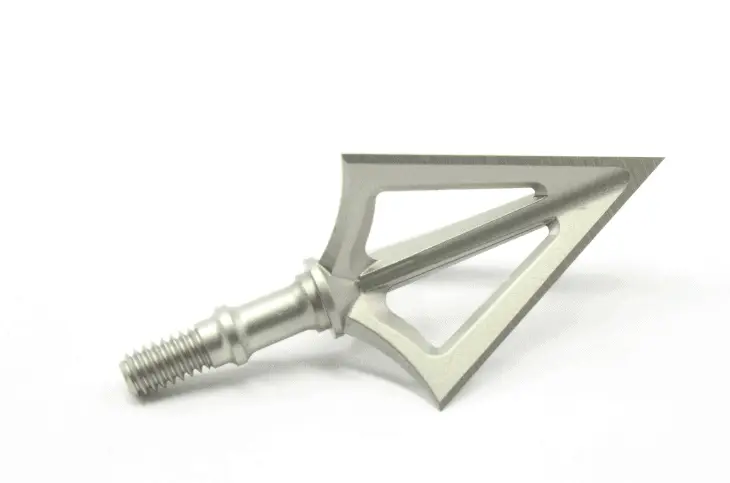
The simplicity is one of the reasons a lot of bow hunters choose to use them: they’re easy to select, easy to assemble, and easy to shoot.
But while they may be simple, they’re pretty darn effective, and an accurate shot with a fixed blade broadhead will fully penetrate an animal, and travel straight through the animal’s body and exit on the other side. If you go to any bowhunting forum, you’ll sees hundreds of photographs of deer hearts sliced in two, and very often it’s a fixed blade broadhead that’s done the job.
Fixed blade broadheads are usually sold in weights of 100 grains or 125 grains, although you may occasionally see 75- or 85-grain options available, and even some that go up to 150 grains. Some have an adhesive and you glue them directly onto the end of your arrow, but most utilize a screw-in design that allow you to install them and tighten them so that they’re secure.
There are two subcategories of fixed blade broadheads: one-piece broadheads that are one solid unit, where the cutting starts at the tip of the arrow and continues down to the base, and replaceable-blade broadheads, that allow you to remove the blades and replace them when the blades get dull. Many bow hunters choose replaceable blade broadheads because they’re convenient—sharpening the blade on a one-piece broadhead can be a pain (and it can pretty dangerous, too)—but there are plenty of folks who opt for the one-piece variety.
As for the blades themselves, fixed blade broadheads (both one-piece and replaceable-blade) are sold in two-blade, three-blade, and four-blade arrangements. If you’re new to bowhunting, it’s usually wise to opt for fewer blades, and smaller ones—larger blades are similar to fletchings, and the larger surface area can make them vulnerable to wind.
One quick note before we move on: you may come across the term “ferrule” when you’re looking at broadheads to purchase. The ferrule is the center of a broadhead, and it’s the part of the broadhead that holds the blades.
Mechanical Broadheads: A Little More Complicated; Also Effective
Whereas fixed blades broadheads stay the same shape during the shot process (that’s why they’re called “fixed,”), the blades on a mechanical broadhead actually move during the shot.
Before the shot, the blades are hold close to the ferrule (if you skipped the last section, the ferrule is the center part of a broadhead), and when the arrow hits its target, the blades expand outward to cut the animal after the arrow enters its body.
Here’s an image of a broadhead with its blades close to the ferrule:
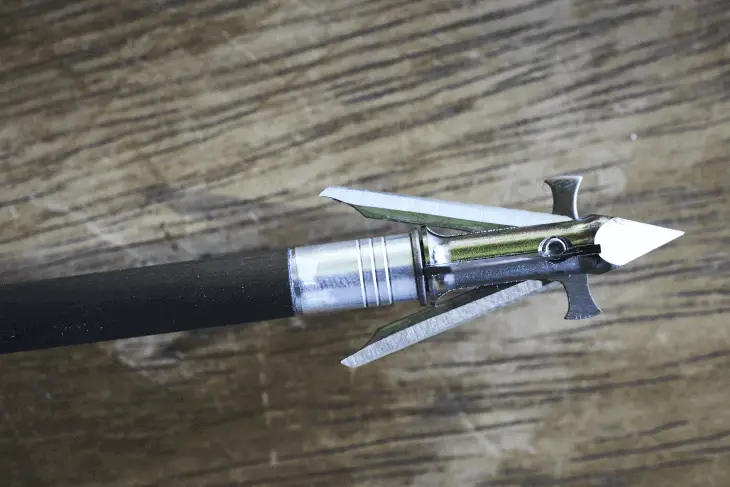
…and here’s an image of a broadhead with its blades expanded:
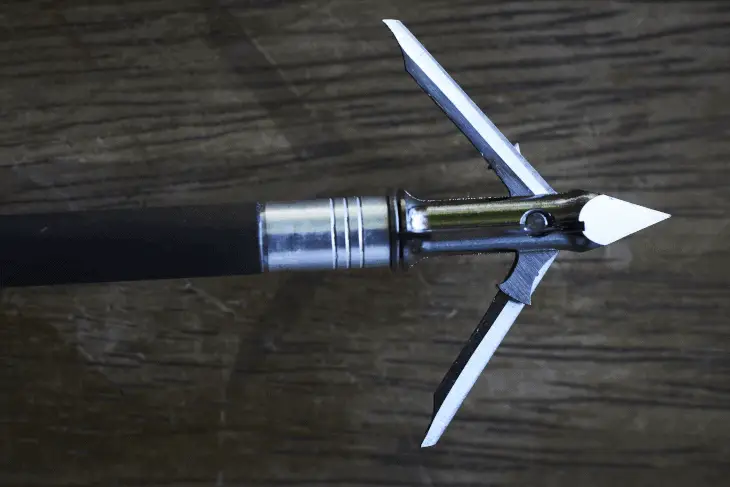
The design is intended to improve on fixed blade broadheads, because when the blades on the broadhead are retracted inward close to the ferrule, the arrow experiences less drag and is less likely to influenced by the wind. They fly a little bit more like arrows that have regular field points (that is, arrows that have a simple sharp time, like the kind you’d use at the archery range), and that can make them a little more reliable on a hunt—when you practice all year with your field tips, the transition to mechanical broadheads isn’t so difficult.
As for weights, mechanicals are usually sold in 100-grain and 125-grain options, and it can be difficult to find 75-grain versions. Most are a threading at their base that allow you to screw them into the head of your arrow.
There are two different subcategories to mechanical broadheads: front-deploying mechanicals, which have blades that swing open from the front of the broadhead to the back, and rear-deploying mechanicals, which have blades that swing open from the back of the broadhead to the front.
Front-deploying mechanicals (sometimes called “over-the-top” mechanical broadheads) deploy inside the animal, and make massive interior cuts. Here’s a very brief video that shows, in slow motion, how front-deploying broadheads work:
As you can see, the blades fold open—a little bit like flower petals would—and the razors are deployed inside the animal. The expansion of the blades inside the animal results in smaller entrance hole, but a full-sized exit hole.
You can compare that to how rear-deploying broadheads open in the video below.
Rear-deploying mechanicals have blades that deploy from the back to the front. Here’s a slow-motion video of how that works:
As you can see, at entry, the blades are pushed open from the back, and they open outside the animal. The advantage of rear-deploying mechanicals is that they create very big entrance holes and entrance holes, which can cause a lot of bleeding and create very visible blood trails after you hit your quarry.
Another Subdivision for Both Types of Broadheads
There’s one other subcategory that applies to both types of broadheads, and that’s chisel tips vs. cut-on-contact tips.
Cut-on-contact tips have a sharp cutting surface at the very tip of the broadhead that slices through skin as soon as the broadhead reaches the animal. They usually look something like the image we posted above:

As you can see, the blade starts at the very top of the broadhead, and upon contact with the animal, it begins lacerating the skin immediately. Compare that to…
Chisel-tips, which have a sharp point that looks something like a pyramid, and are designed to pierce an animal’s hide before the blade of the broadhead gets there. They look something like this:
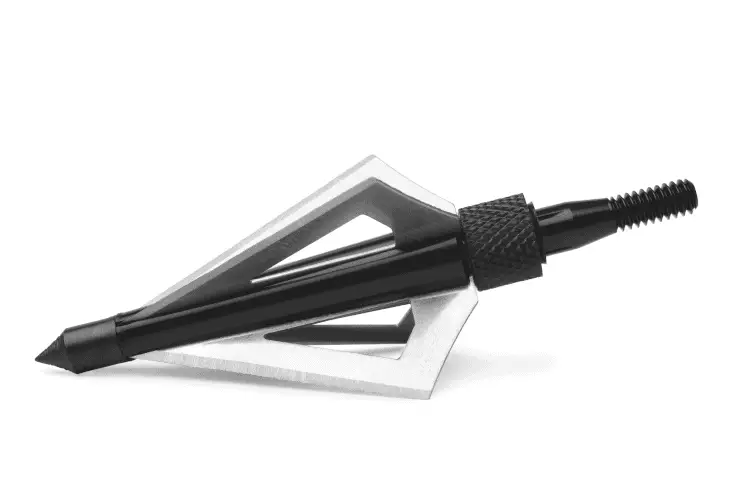
Usually the tip is a little bit more chiseled, and looks like this:
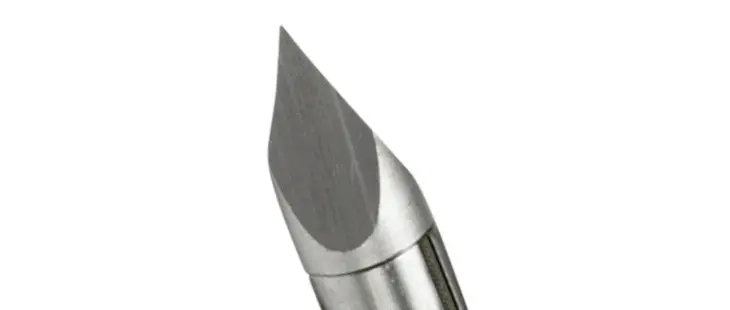
As you can see, the blades are actually located a little bit behind the tip, and the tip itself is designed to punch through your game’s hide.
Opening the hide before cutting with the broadhead can be a good thing, because it allows the arrow to continue to penetrate the animal’s flesh in an unaltered trajectory, and if you’re letting off shots from odd angles—like from a tree stand, for example—you want your arrow to continue through the animal in a straight path. Chisel-tips are also very sturdy, and many are able to cut through bone and maintain their shape.
You may be thinking, “Those names are slightly misleading,” because a chisel-tip broadhead does, technically, cut the skin on contact, but that’s how it is.
Also Available: Hybrid Broadheads
These are a “best of both worlds”-type of broadhead, that combines elements of both fixed blade broadheads and mechanical broadheads—usually the triangular shape of a fixed-blade broadhead and the expandable blades of a mechanical broadhead. They’re usually made in 100-grain and 125-grain varieties, and while there aren’t too many of these on the market, we’ve reviewed a few of them in this post.
And there you have it! You now have a working knowledge of broadheads and how they work.
Which Type of Broadhead is Right for Your Hunt?
Welcome to the Great Debate. Veteran hunters all have an opinion about which type of broadhead is better, and most of them (most of us!) are absolutely, 100% certain that one is better than the other.
But here’s the thing: all of those opinions are based off personal experience. When someone says, “Fixed blades are better than mechanicals, period”—or vice versa—what they’re really saying is, “When I take my bow and go hunting, here’s what I find works for me.” There are very few studies or tests that show one is superior to the other, and the only research we know about (see page 47 of 77 here) actually shows that in a study of over one thousand bow hunters, there was no difference in performance when it came to fixed-blade broadheads vs. mechanical broadheads.
With that said…
There are some generally-agreed-upon guidelines about broadhead selection, and they include:
Your Experience Level
Generally speaking, if you’re a new bow hunter, mechanical broadheads are usually the better option. Here’s why:
The blades on fixed-blade broadheads have a lot of surface area, and that can create a lot of drag as it flies through the air. If your bow isn’t finely tuned—and tuning a bow is a skill you’ll develop over many years of shooting—a fixed-blade broadhead can be very difficult to shoot accurately. That’s especially true for bows with a high foot-per-second measurement—a fixed-blade broadhead shot from a poorly-tuned, high-FPS bow can be difficult to shoot accurately.
On mechanical broadheads, however, the blades are tucked in close to the ferrule during arrow flight, which means it’s less susceptible to drag (and a less-than-perfectly-tuned bow). That sort of “forgiveness” is a fantastic thing for a new bowhunter to have, and it’s easier for new bow hunters to shoot accurately when they’re using mechanicals.
(And, before we move on, if you’re a veteran bow hunter and you think we’re wrong, please feel free to jump over to our “Contact” page and let us have it! Keep in mind, from what we’ve seen, novice bow hunters shoot more accurately—and put down game more reliably—when they start off with mechanical broadheads)
Now, here’s the trade-off: mechanicals may be easier to shoot, but you need to consider…
The Size of the Game You’re Hunting
As a general rule of thumb, the bigger the game, the more likely you’ll need a fixed-blade broadhead.
Even though they’ve come a long way since their invention decades ago, mechanical broadheads can be somewhat fragile. There are a lot of moving parts, and those parts are small and finely made and delicate, and while they provide each excellent cutting potential—they are, after all, razor blades at the end of your arrow—they can’t always provide the same punch that a fixed-blade arrow can create.
Some fixed-blade arrows are so sturdy, that a heavy arrow, tipped with a fixed-blade broadhead, shot from a heavy bow, is not only capable of cutting through hide and muscle and tissue, it’s been known to punch through bone, and that’s about all you can ask for when it comes to a broadhead.
Your ultimate goal as a bow hunter is to achieve pass-through penetration of your quarry with an arrow, and a solid broadhead is often the best tool for the job, because that’s the kind of cutting/penetrating power you’ll want for hunting big game like elk, moose, bison, and wild boars.
As the size of your game gets smaller, it makes more sense to opt for mechanicals. They truly are excellent at cutting through those squishy vital organs, and when shot accurately, they can put down small-to-medium sized game, like deer and turkey, quickly and ethically.
Plus, because they usually have a wider cutting diameter than fixed-blade broadheads, they tend to create large entrance- and exit-wounds, which create larger blood trails for you to follow after you connect your arrow. If you’re a new bow hunter, having a clear blood trail to follow can be very helpful.
It all works out pretty well, because most new bow hunters aren’t going after those large animals—they’re most likely going after white-tail deer, mule deer, or turkey—and mechanicals can be a great option for game that size.
The Draw Weight on Your Bow
If you’re shooting a lower-poundage bow, usually in the neighborhood of 55 pounds or less, you’ll want to opt for a fixed-blade broadhead (and preferably one that is cut-on-contact).
That may seem a little bit surprising, because as we’ve said, mechanicals are better for beginners, and beginners tend to shoot lower-poundage bows, but it’s true. Here’s why:
As we mentioned earlier, the most important aspect of a bow hunting arrow is its ability to penetrate an animal and pierce the animal’s vital organs. That’s the most reliable way to put down the animal quickly and painlessly, and it should always be your #1 goal as a bow hunter: a quick and efficient put-down.
Bows with a draw weight of less than 55 pounds do not usually shoot arrows forcefully enough to penetrate the animal and pass through it, and that’s a very, very bad thing—it can merely wound the animal, making it suffer, instead of putting it down completely. An arrow with a fixed-blade broadhead can improve penetration, and make up for that lack of force.
Even though they may be a little more difficult to aim, if you shoot a bow with a lower draw weight, a fixed-blade arrow (that is cut-on-contact; see above for a definition of what cut-on-contact means) is usually a better option.
How Much You Enjoy Replacing Equipment
Generally speaking, fixed blade broadheads tend to be a little sturdier than mechanicals, and they tend to last longer. That’s not true for every make and model, but that’s our experience. It makes sense, too—they have fewer moving parts, and the blades themselves are usually a little thicker.
Lastly, you should consider…
The Tool That Strikes Your Fancy
This sounds odd, but in the world of archery—where personal feelings about gear are often a deciding buying factor—you may want to simply go with your gut. If all else is equal, and you’re able to put your game down with either type of broadhead, why not pick the broadhead that speaks to you?
Some guys like the simplistic nature of a fixed blade broadhead, because it’s similar to the arrowheads that fellow bowhunters have been using for millennia. Other bow hunters love the idea of a specifically-engineered slicing machine (and the huge entrance holes and exit holes they can provide), so they go with mechanicals. If there’s a voice in your head telling you like one more than the other—and your selection will result in a quick, ethical drop of the animal—choose the model that gets you going.
Wrapping Up Which Broadhead is Right for You
You may have noticed that there are a lot of trade-offs when it comes to broadheads. Fixed-blades have strengths in one area and weaknesses in another, and mechanicals are the same way. Here’s what it boils down to: fixed-blade are probably more powerful, but they’re difficult to use. Mechanicals are also pretty darn effective—and more forgiving—and they’re easier to use.
Ultimately, nothing beats experience. Use both, and see what works for you, because if there’s one thing we’ve observed, it’s that the effectiveness of broadheads is an incredibly personal thing. There are so many factors at play—both knowable and unknowable—that what works for someone else may not work for you, and what works for you may not work for someone else. Find what gets the job done when you’re on the hunt, and work with that.
Make Sure Your Broadheads are Sharp, and Happy Hunting!
When used—and tuned—correctly, broadheads can be an incredibly powerful tool. Take your time, find the broadheads that work for you, do some flight tests to make sure you can group them… and then happy hunting! We wish you the best of luck.

